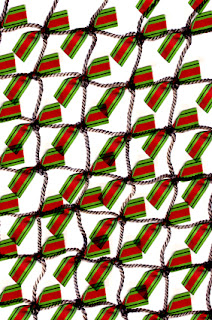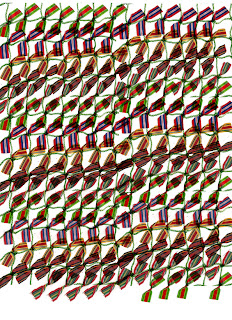Gott Mit Uns (God With Us)
A continuation of the theme of all the protagonists engaged in conflict invoking God as explored in the artillery pieces. The Germans went into battle in WW1 with the legend 'Gott Mit Uns' displayed on their belt buckles. On the other side of no-man's land the Allies were busy saying prayers to the same God to protect them from the oncoming Germans. It's an interesting question to ask just who's side is God on?
This image is an illustration of that question. It by no means offers an answer.
The accidental stained glass look is prevalent again. This time it has been provided by a background made up of Lozenge pattern camouflage, masquerading as fragments of glass. Lozenge pattern was developed by Franz Marc after the outbreak of WW1. Along with Dazzle pattern, its purpose wasn't to conceal but to confuse. It was developed for the use of the German Air Force who wanted a system of camouflage that would blur the outline of their planes making identifying difficult. The effect of this would be to make enemy planes reluctant to attack. Marc developed a series of colour combinations based around the principles of Impressionist colour techniques which when applied to the shapes of biplanes and viewed from a distance had the effect of merging the different forms such as fuselage, wings etc into one amorphous shape. Marc created a whole series of these combinations which would vary depending on the season they would be used in so they would also match the colours of the landscape below, adding to the confusion. Marc called these colourful pieces his 'Kandinskys' alluding to the abstract fragmentation seen in the work of Wassily Kandinsky. Marc was killed in 1916 at the Battle of Verdun.
The first image here is from my sketchbook and features the text from Ephesians 6, translated into German which talks about taking "the helmet of salvation and the sword of the Spirit, which is the word of God".
The large guns flanking the image are German Maxim machine guns which were infantry support weapons. The weapon took its name from Hiram Maxim, an American inventor responsible for the development of the first workable machine guns. The British, American and Russians all used machine guns which were versions of this weapon. So not only were we using the same god to justify our actions, we were also trying to kill each other with the same weapons. They sit here like temple pillars, protecting the central elements in a seemingly ceremonial role. The two helmets are German Stalhelms. Introduced in 1916 they were a revolution in helmet design and one which offered much more protection than the French and British steel helmets worn on the Western Front. It's still a very effective design, just take a look at modern U.S helmets. The lower helmet has a detachable steel plate fitted to the frontal section. I see this as an allegory for going into battle with God on your side; you have extra protection.
 |
| Gott Mit Uns Digital image and watercolour |
 |
| Gott Mit Uns Marker pen |































